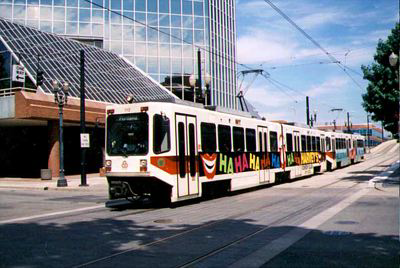No Light Rail in Vancouver!
Transit Follies #1: The North Shore Connector

What better way to celebrate April Fools week than with a series of transit follies! Each day this week, the Antiplanner will describe a transit folly that is not in Portland, Denver, San Jose, or another city that I’ve harped on so much in the past. By the end of the week, I hope you will agree that transit agencies everywhere in the U.S. have been made foolish by the misincentives created by federal pork barrel.

Light-
First up is the North Shore Connector, an extension of Pittsburgh’s light-
So what do you do? Why, spend $435 million on a 1.2-
It is breathtaking to think about it: $435 million on a mere 1.2 miles. That’s $362.5
million a mile! For that, you could build ten miles of a four-

The North Shore is in the foreground, with downtown Pittsburgh in the background. The tunnel will be to the left of the major freeway bridge in the center of the photo. The Steelers play in the stadium at far right; the Pirates play in the stadium at the left
Pittsburgh needs this line, says a Port Authority official, “if Pittsburgh and Allegheny County are to further grow and develop.” Further grow? I don’t see any growth. The Pittsburgh metropolitan area lost 3 percent of its population in the last 15 years. In the same period, Allegheny County lost more than 8 percent of its residents, Pittsburgh lost 15 percent, and transit ridership dropped by 22 percent.
Building the North Shore Connector, adds the transit official, “effectively expands the city’s central business district.” But what it really does is further promote the decline of the existing downtown area.
“Given the fact that much of downtown is in serious decline and in need of a lot
of help,” says the Allegheny Institute for Public Policy, “it boggles the mind that
anyone would believe that creating additional government-
The Port Authority claims that the chief benefit of the North Shore Connector is
that it “will support approximately $377 million in new economic development.” Excuse
me, we are spending $435 million tax dollars to “support” $377 million in new development?
Note that they didn’t claim outright that the light-
The new line will also serve the Pittsburgh Steelers football stadium and the appropriately named Pittsburgh Pirates baseball stadium. Needless to say, it is extremely important to federal taxpayers that Pittsburgh sports fans can get to their stadiums by light rail. I believe it is in the Constitution somewhere.
The light blue line shows the North Shore Connector (click on the map to see a larger version, then use your “back” button to return here). Notice the red line forebodingly projects a future extension to the airport. How many billions will that cost?
What is really propelling the connector is other people’s money. Allegheny County is only putting up $14.5 million of its own money. Another $72.5 million is coming from the state. The rest is federal, including $261.2 million in transit funds and $86.8 million in flexible funds. Flexible means the money could have been spent on either highways or transit; this way, the Port Authority has managed to capture it instead of some highway agency. Construction has already begun, but they don’t expect to be done until 2011.
How did they manage to get OPM for this boondoggle? Through the time-
So the Port Authority cut off three-
The actual cost ended up $72 million more than the estimate that won federal funding, and $45 million more than the estimate that was denied federal funding. Meanwhile, ridership projections dropped to 14,300; we can only imagine what the actual ridership will be. No matter how many ride the thing, you can be sure that the Port Authority will declare the project a great success. Would you expect them to brag that they wasted your money?
Part of the problem is light rail. Maybe the Allegheny River needs another bridge,
or even a tunnel, to deal with traffic; the existing bridges connecting downtown
with the North Shore are supposed to be pretty congested (though the Allegheny Institute
says Pittsburgh has more serious bottlenecks elsewhere). If a highway bridge or tunnel
were built, the cost (which would be a lot lower than $435 million) could be shared
among all the autos, trucks, and buses that used it. By building a dedicated light-
But the real problem is federal transit funding. Unlike highway funding, which is
allocated to the states using a strict formula, transit funding is provided on a
first-
2
Trackback • Posted in Planning Disasters, Transportation
Reprinted from The Antiplanner
